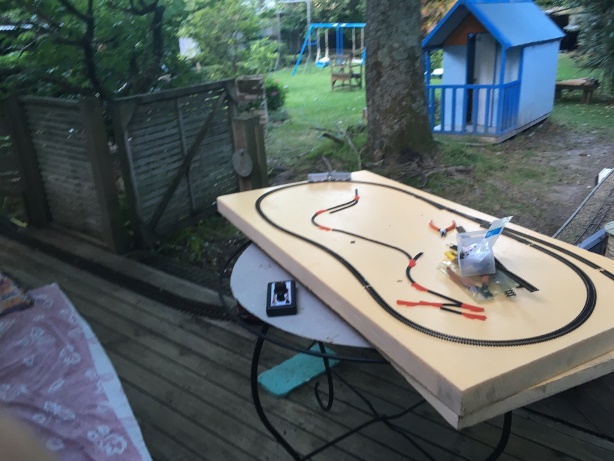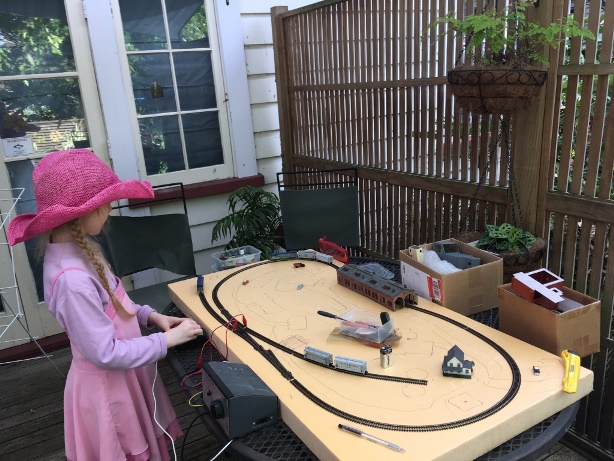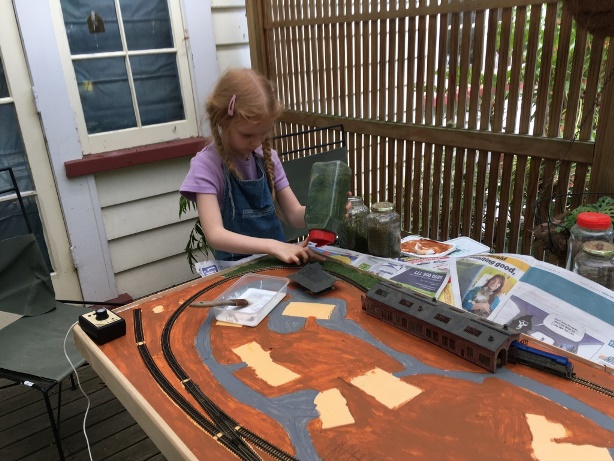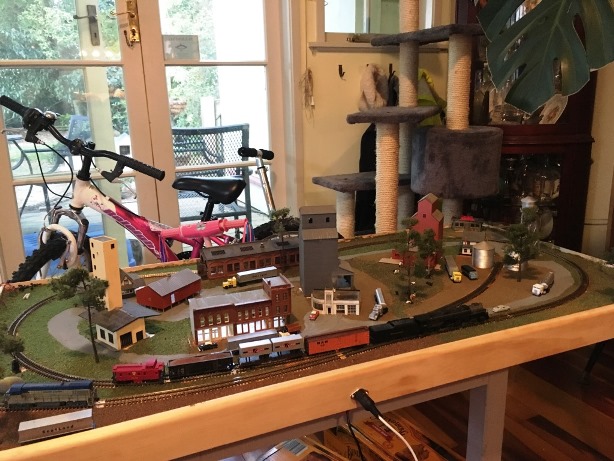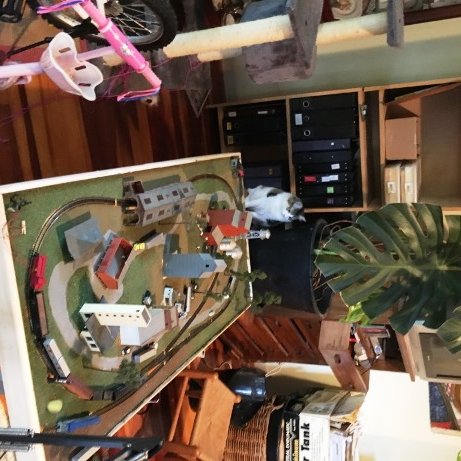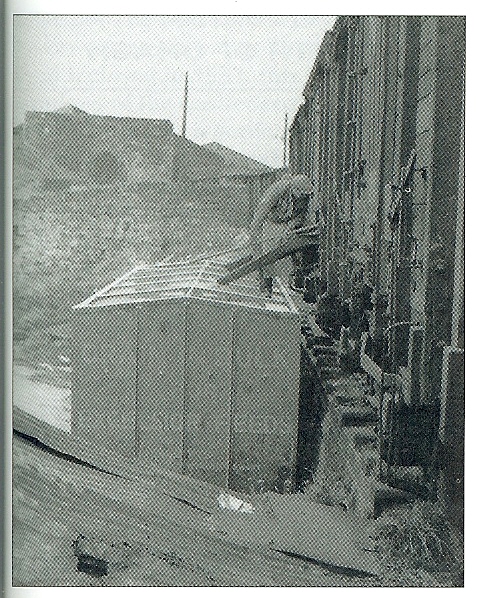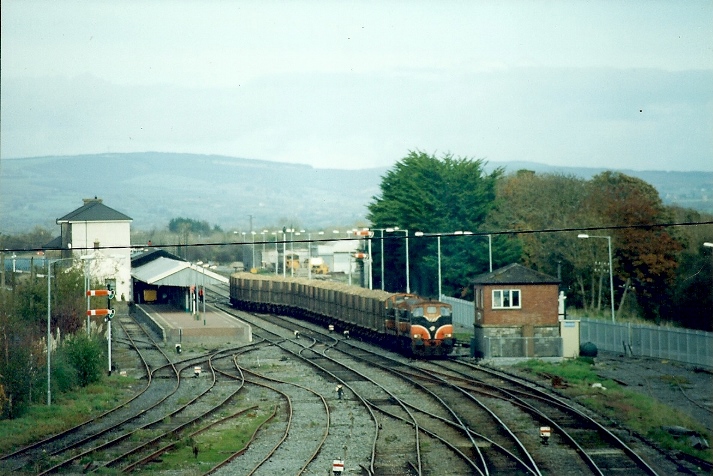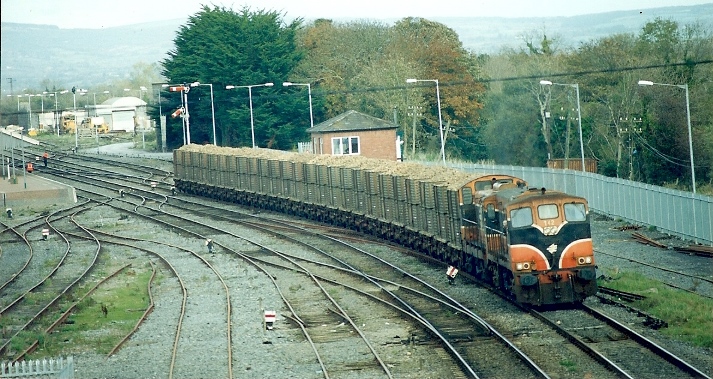-
Posts
4,875 -
Joined
-
Last visited
-
Days Won
119
Content Type
Profiles
Forums
Events
Gallery
Everything posted by Mayner
-
Nelson. Nice to see you jumping in at the deep end and fabricating your own W Irons for the 6w van. Practice with the piercing saw and your soldering it will open up endless modelling possibilities. I stlll have the saw I bought nearly 40 years ago unfortunately I don't use it to the same extent as when I was in my teens & 20s. Keep up the good work
-
This happened before with the Dublin & Drogheda and the Ulster Railway setting out to build a railway to two different gauges fortunately they kept to the same scale To confuse things further David Malone has built a model of Cliffony on the MGWR line to Bundoran to 21mm gauge S4 standards. Photos of some of David's models including Cliffony station & signal cabin appeared in the short lived Rail Model Digest in the 1990s. Funnily enough the buildings bear a striking resemblance to Dromad.
-
It would be interesting to find out how serious CIE/Merrion St were about taking over the lines. By all accounts both Transport Ministers had a good working relationship and Merrion St was beginning to think in similar terms about the railways to their northern counterparts. The closures worked pretty much in CIEs and the Irish Governments favour by closing down a competitor and diverting cattle traffic away from Belfast & Derry to Dublin Port, so there seems to have been an element of realpolitik on both sides. There was a proposal immediately before closure (prompted by the shippers) for the SLNCR to take over the Ennskillen -Omagh line as a "siding" for cattle traffic from Colloney, theB101 Sulzers would have been just right for the job if Waterford would part with one!
-
Nice what if the Bundoran line had of reached Sligo or if Merrion St had taken up Stormant's offer and taken responsibility for operating the GNR Border lines and making up the losses in 1957 Very atmospheric I am pretty much hooked on eye level baseboards the Bullhead track really adds to the effect. Are you planning to add any GNR locos and stock? The Bundoran Express with a OO Works U Class & 4 modern GNR coaches would be a real eye catcher & a nice contrast to the drab CIE greys and greens.
-
Its hard to believe that IE are still relying on hand signals for shunting 20-30 year after most railways including British Rail adapted 2 way radio communication, especially in a yard like East Wall with curving roads where its difficult to maintain a clear line of sight between the driver and the shunting crew on the gound. The shunter controlling the move should have signalled the driver to stop 1-2 wagon lengths back from the Liner until he (the shunter) could accurately judge the distance between the Liner and his cut of wagons. In the States & New Zealand the brakeman or shunter unsually rides on the end car to reduce the amount of walking, chopper or knuckle couplers have largely eliminated the risk of being squashed between cars while coupling up.
-
Outdoor soldering station I made up a soldering iron stand from a piece of 6x2 and an old Litesold stand after picking up the iron by the hot end . The minidrill was for rail cleaning but a piece of wet and dry turned out to be less bother. Container is a rust convertor diluted 50% with water, worked a threat. The leads are fed through an ELCB just in case I do something stupid with the cable. Not terribly clean rails. Tinned One I did earlier. Allowing for expansion s important, I had joints fail where I did not allow enough. I use an LGB graphite paste for lubricating the fishplates when 1st laying track, which also helpe to maintain conductivity.
-
Although large scale I thought this might be useful for anyone considering or using DCC I recently restored track power to the garden railway after a major re-sleepering programme. Basically I have had to replace about 50% of sleepers on the main line after 7-8 years use as a result of UV damage. Although most of my locos are now battery electric, I though it was a good opportunity to upgrade the DCC system rather than converting all of my locos to on board battery power. Schematic of railway showing power districts The main line has a 2% ruling gradient, the High Line 4% which limits loadings and results in high current draw from locos climbing the grades. I divided the Large Scale layout into separate power districts protected by DCC Specialties Power Shield PSX1 circuit breakers. These both protect the DCC Command station and avoid shutting down the entire railway in the event of a short or a loco de-railing and should simplify trouble shooting. Control system for Large Scale Digitrax DB150 ampmeter, Radio & IR receivers and DPDT isolating switches for Power Districts The circuit breakers have basically eliminated the need to return command stations to Digitrax for in service fault repair. The circuit breakers are fed through DPDT switches bought from Peats of Parnell St about 40 years ago, the circuit breakers and Digitrax Command station was used on a layout in Dublin before moving to New Zealand in 2004. The radio receivers and radio throttles were bought about 5-6 years ago when we moved up from N to G Scale Circuit breakers behind panel Hidden away beneath the N Gauge. The DCC control system for the large scale layout lives on a shelf below the baseboards currently used to support the N gauge. The biggest job was the bonding of rail joints, most of the rail is heavily weathered after 9-10 years use in the humid Waikato climate. The Code 250 brass rails are used to conduct power rather than a parallel power bus, wiring between the shed and individual blocks or power districts is by a combination of mains and outdoor low voltage cabeling. I clean the web of the rail using 240g wet and dry, and use a cheap 70watt soldering iron with resin cored electrical solder. I use a drop of phosphoric acid flux (10-15%) diluted from a liquid rust convertor (28%) as a wetting agent which improves the flow of solder. The Waikato rain neutralises the flux.
-
I am not sure why you are considering scratch building when most of the common GNR & CIE wagons are available in kit form or RTR. Provincial Wagons produce some very nice kits and rtr models of GNR (I) wagons including the standard covered van, cattle wagon, 30t brake and bread container wagons. The CIE H van & Corrugated Opens are also available http://www.provincialwagons.com/2.html. SSM (Weshty) of this parish produces a nice whitemetal model of the standard wooden framed open wagon used by the GNR & GSR/CIE http://www.studio-scale-models.com/Freight.shtml#
-
As far as I know 18T is still on the Pine Creek Railroad in New Jersey along with C&L No3 Lady Edith. The Cavan & Leitrim have a pair of complete but un-restored T&D coaches rescued from a builders yard in Callan in the carriage shed in Dromod. Lady Edith and her train was restored and operated for several years after arrival in the United States nearly60 years ago and no doubt a major overhaul/rebuild costing the best part of $250k is required to restore the train to service
-
Wow! David you are fast worker David! I like the DAS clay on foam board for stone buildings. Will the station building be in brick similar to other CVR stations or was Fintona built I stone by a local company?
-
Great to hear that you have started tracklaying? Post 240 on this RM Web thread will give you an idea of the work involved with installing working point rodding http://www.rmweb.co.uk/community/index.php?/topic/76110-moving-coal-a-colliery-layout-in-0-gauge/page-10
-
Roscrea Parkway? follows a similar pattern to the UK rural station with good road connections serving a reasonably well populated hinterland with a number of reasonably large villages and towns and villages. More convenient to catch the train at Ballybrophy than drive to Portlaoise of Dublin or use the Nenagh Branch
-
That's it exactly our daughter got a great kick out of the Thomas and Chuggington wooden railways at the railway museums and tourist railways we visited in the States last year, the sheer hands on playability factor. Smaller kids particularly girls incorporate the railway in their imaginary play giving the locos, cars trucks and animals personalities. Since we got the signals working the Sheriff's car is busy going around keepin law and order handing out citations to the other cars and trucks on the layout and even the poor John Deere tractor and the loco for a SPAD
-
Last week my daughter Skye asked me why she could not run train on the N gauge layout I have stored in the garage for the best part of 10 years. Rather than try and get the layout up and running I thought it was a better example to follow Dave's example and build the layout under a Lend-Lease arrangement in return for running powers at some future date Skye turned out to be a good project manager (cracking the whip) we had trains running after one evening and most of the scenic complete after 4 days. Dad was responsible for the civil engineering, trackwork and electrics, herself taking charge of town planning, scenics and the raod transport side of things. The Beginning a sheet of foam board and some Peco flexi track I bought a 4X2 sheet of foam board about 3 months ago for a mock up for a 4mm layout, I used Code 80 Flexible track for the curves because I already had the track in stock and had no set track. Track is pinned down to the foam board with Peco track pins which was interesting. Town planning complete and test running The points are large radius because I sold my stock of medium points about 2 years ago, I have a diamond crossing stashed away somewhere for a overlapping spur but cannot find it. Skye likes to park the loco overnight in the loco shed 1st time its been used for its intended purpose in over 20 years. Day 3 I think Skye applying Woodland Scenic ground cover on dilute PVA (Art Attack Glue!!!) after paint dried Nearly complete! Trying out 25 year old Con-cor Rivarassi Challenger The real controller Babuska also keeps an eye on the Large Scale layout
-
There is a lot of work in setting up a working point rodding system on a OO gauge mode. Personally I would a wire and tube or push rod system described by David under the baseboard and the Wills cosmetic point rodding above the baseboard. http://www.hattons.co.uk/62545/Wills_Kits_SS89_Point_Rodding_Kit/StockDetail.aspx
-
-
LQG109 shunting at Omagh North 1954 Photo N W Spinks No obvious ballast shoulder in the area in the area between the signal cabin and platforms where staff were likely to be walikg plus all important cinder path from cabin to platforms. It looks almost like the goods shed was re-roofed and the high gable wall with the 3 arched windows cut down at some stage after the 1954 photo
-
CIE originally planned to operate the Supertrains & MK3s as push pull sets, even getting to the stage of building a MK2D driving cab mock up but it never happened because o funding restrictions. The Park Royals, Cravens & MKDs had similar service 30+ years life to GSR built stock. Replacing the MK3s with Rotem's made sense in the same way as the replacement of DMUs and loco hauled stock on Regional Lines in the UK in the 1980s with Supersprinters which allowed a much more frequent service to be operated at a lower cost.
-
Found it ! Photo was by the late Des Coakham The truck was said to be owned by Scotts the local millers. The load could well be animal feed rather than wheat for milling, the legend "Excelsior Feeds"is just about visible on the truck
-
There is a photo in one of the Ian Allen Irish Railway Pictorial Albums of one of these wagons discharging grain from an elevated siding into a large bulk grain truck in Omagh goods yard. Difficult to describe the siding appears to be supported by a massive retaining wall that allowed trucks to draw alongside to load, which helps explain the side chutes rather than the more common bottom doors used with grain wagons Perhaps Tony may have a photo of this part of the yard.
-

Irish freight yards and sidings. Prototypical operation and detailing.
Mayner replied to dave182's question in Questions & Answers
CIE/IE use/used a number of different options for controlling the connection between a yard and running line. The connection is usually involves a crossover and head shunt or a set of trap points to protect a passenger carrying line. Signal Cabin control. Control from a local signal box with mechanically operated points and semaphore signals was the most common up and down the country up to the widespread conversion to CTC. The GSR/CIE converted a number of Junctions to remote operation from the 1920s onwards. The Junctions between the Burma Road and Sligo Line at Colloney controlled from Ballysodare and Manulla Junction controlled from Balla are good examples of junctions controlled by motor driven points and semaphore signals. Full sized or shunt signals were used depending on the pattern of operation, with a “mother & child”semaphore signals an arriving train would be stopped before entering a yard and the calling on arm of child” signal lowered to allow the train to enter the yard at restricted speed. Full sized signals were increasingly used for controlling departures from a yard onto the main during the Liner Train era. Longford was a good example of a yard with full sized departure or starting signals during the Rail Plan 80 era Dundalk South Junction was a more modern example using miniature colour light signals controlled from Dundalk Central. There does not appear to have been a facing connection from the down main to the Barrack St branch, which resulted in interesting shunting movements between Dundalk Central and Barrack St yard. Ground frame control. Several yards are/were controlled by ground frames operated by the train crew. Entry to and from the yards at Kildare and Portlaoise are controlled by ground frames released by Connolly CTC, The ground frames at Shelton Abbey sidings on the Rosslare line used to be unlocked by the Rathdrum-Arklow section staff. Access to and from the yard would be controlled by shunt signals where ground frames are used. Not a freight yard as such Limerick Junction South plenty of discs and trap points. Sidings were mainly used for attaching/detatching passenger train tail traffic. Beet Special crossing over from Platform to Down Main Special propelling back along Down Main to allow Down Passenger to pass from Southbound Platform to Down Line Disc & calling-on arms lowered for backing move along down main -

Narrow Gauge in the Rockies not quite
Mayner replied to Mayner's topic in US / Canadian Railway Modelling
Did'nt manage to get much done on the modelling front over the Christmas apart from some large scale track maintenance and fitting one of the locos with a Mylocosound sound card. Not 100% happy with the whistle, but reasonably happy with the chuff, safety valve and air pump sounds. -
CIE hired and later sold a number of G Class including 616 to the Sugar Company. to supplement their Rustons shunting at the Thurles Factory.
-
Hope I am not hijacking the thread. Time and whether a person prefers running trains to building models are probably the greatest factors in favour of OO compared with EM, P4 or 21mm gauge. I think it was Cyril Freezer the late editor of Railway Modeller that said that it took twice as long to get an equivalent layout running in EM as OO gauge. This probably applies to a greater extent with Irish Broad gauge, apart from Murphy Models diesels & IRMs forthcoming wagons are relatively easy to re-gauge, the majority of Irish rtr coaches, wagons and locos need replacement bogies and running gear as there is insufficient clearance between for 21mm wheel sets. I am don’t know how Martyn Wynne came up with 20.2mm for 5'3" gauge in Templot For many years 4mm Irish modellers lay their track to the correct 21mm gauge whether working to EM or P4 standards. Tim Cramer built a 21mm gauge layout with a 19.5mm back to back in the early 1970s before moving up to O Gauge with coarse scale wheel standards just like the late Drew Donaldson! TMD supplied 21mm roller and a 19.5mm back to back gauge during the mid 80s The Loughrea layout was built to 21mm gauge to EM standards with a 1mm flangeway and 19.3 back to back during the early 1990s. Locos and stock with 19.5B_B run fine on this track work One of Tim’s locos a Bandon Tank preformed regularly operated on the Loughrea Layout together with a GNR JT built about 20 years earlier by the Harry Connaughton a professional model builder For someone who prefers operation to building the new Peco bullhead track should be a reasonable compromise for a pre-2000 OO gauge Irish layout and is apparently designed to be compatible with their Code 75 track system. which should be a lot easier to curve than the standard Streamline Code 100 track http://www.anticsonline.co.uk/1263_1_2848804.html.
-
Great layout Noel OO at its best! Reminds me of some of the plans in CJ Freezers plan book for larger layouts and the Rev Edward Beal's West Midland Railway. One word with the tank train if its carrying Class A (petrol) should have at least a couple of vans or mineral wagons as barriers between the tank wagons loco & guards van. At one time CIE used a nice rake of silver Texaco tank wagons on the North Wall-Inchacore oil train
.png.c363cdf5c3fb7955cd92a55eb6dbbae0.png)



.jpg.60c2eee09f4af5aeeaaeb2e1886698e2.jpg)
.jpg.c91e07ad782ec1eaad7a8425efaedf17.jpg)
.jpg.fd4aa08140991044a8de47bce323dea5.jpg)
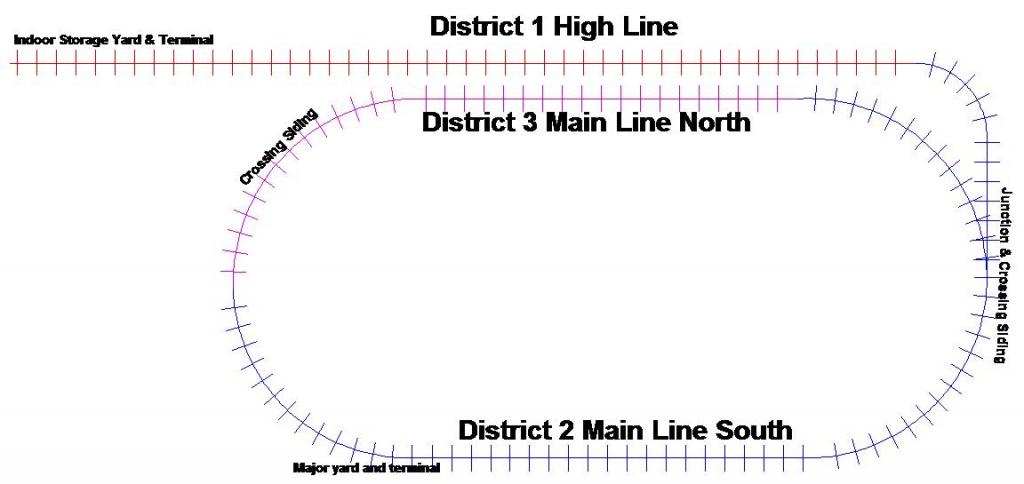
.jpg.615671536fcb2d94a554d6a312d15f16.jpg)
.jpg.223c0ee9b8a4b00a65715a21f197b982.jpg)
.jpg.60e1325c1cac3c3a122decb3432c4523.jpg)
.jpg.8760460075b3a118c3d7a5f749bf39c1.jpg)
